|
THERM-A-REST QUESTAR 0F/-18C
TEST SERIES BY STEVEN M. KIDD
LONG-TERM REPORT
July 19, 2018
CLICK HERE TO SKIP TO THE FIELD REPORT
CLICK HERE TO SKIP TO THE LONG-TERM REPORT
TESTER INFORMATION
|
NAME:
|
Steven M. Kidd
|
|
EMAIL:
|
ftroop94ATgmailDOTcom
|
|
AGE:
|
46
|
|
LOCATION:
|
Arrington, Tennessee
|
|
GENDER:
|
M
|
|
HEIGHT:
|
5' 9" (1.75 m)
|
|
WEIGHT:
|
185 lb (83.90 kg)
|
|
SHOE SIZE
|
10.5 US
|
Backpacking Background: I've been a backpacker on and off for over 30 years. I backpacked as a Boy Scout, and then again almost every month in my twenties, while packing an average weight of 50+ lb (23+ kg). In the last several years I have become a hammock camping enthusiast. I generally go on one or two night outings that cover from 5 to 20 mi (8 - 32 km) distances. I also do several annual outings lasting four to five days covering distances between 15 to 20 mi (24 - 32 km) per day. I try to keep the all-inclusive weight of my pack under 20 lb (9 kg) even in the winter.
INITIAL REPORT
PRODUCT INFORMATION & SPECIFICATIONS
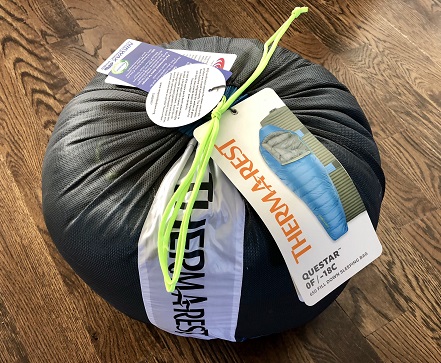 | | Questar 0F/-18C as it Arrived in Storage Sack |
Manufacturer: Cascade Designs, Inc.
Year of Manufacture: 2018
Manufacturer's Website: http://thermarest.com;
MSRP: US $299.95 - $349.95
Listed Weight: Small-2 lb 12 oz (1237 g), Regular-3 lb (1360 g), Long-3 lb 3 oz (1445 g)
Testing Regular Size
Measured Weight: 45.8 oz (1298 g) Bag Only
Other Measured Weights: Bag+Stuff Sack+SynergyLink Connectors: 48.7 oz (1446 g)
Color: Light Blue exterior with Light Green zippers and a grey interior
(As of the writing of this review the bag has not yet been released to the public, so I'm uncertain of official color names)
The Therm-a-Rest Questar 0F/-18C sleeping bag is a new Spring 2018, addition to the Trek & Travel line offered by the manufacturer. This bag adds four-season use to the current Questar line of bags. The Questar bag offers a myriad of features as follows:
*ThermaCature radiant heat technology: This is a Therm-a-Rest proprietary reflective lining designed to capture the body's radiant heat and add warmth without adding weight or bulk.
*SynegryLink: These are patent-pending connectors that join the bag to a sleeping pad. It is designed to minimize the chance of the bag occupant slipping off the mattress during the night.
*Responsible Down Standard Certified: The geese and ducks that provided the down used in this product were treated humanely.
* Nikwax Hyrophobic Down 650 Fill: The bag uses a 650 down fill that dries three-times faster than untreated down without using PFC's (fluorocarbon-thought to cause cancer).
*Toe-asis Foot Warmer Pocket: A pocket in the toe-box of the bag designed to allow immediate warmth upon entry and additional warmth throughout the night.
*Zoned Insulation: Designed to maximize warmth while minimizing weight.
*Quilt and Blanket Loops: Designed to customize the sleep system by layering other Cascade Design/Therm-a-Rest quilts or blankets to increase warmth during sleep
*Other Features Include: Neck Draft Collar, Full-Length Zipper Draft Collar, Snag Free Zipper, Cinching Hood, External Zippered Storage Pocket
INITIAL IMPRESSIONS
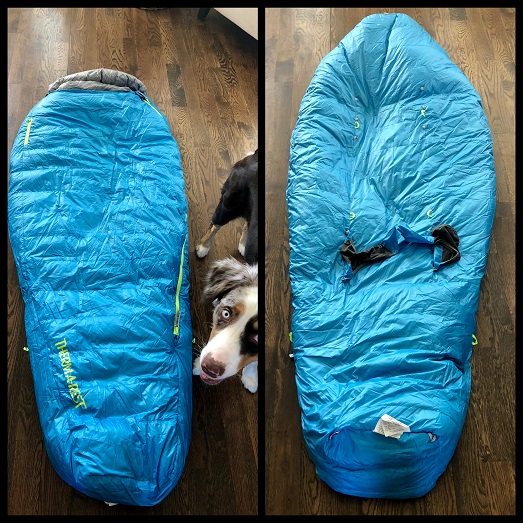 | | Front Side/Back Side |
The Questar 0F/-18C Sleeping Bag looks to be an excellent product based upon my initial inspection. It is well made, clean stitching and zero loose threads to be found. The bag was made in China. The majority of items made by this manufacturer are made in Seattle, Washington or Ireland, so I found that interesting.
It certainly offers some very nice features aside from those mentioned in the specifications section above. Primarily I am impressed with the loft of the bag. It is a 650-fill down product, which makes it a little more affordable than higher loft count products, but it feels nice and light to the touch. I can feel no feathers, only down.
A snag free zipper is mentioned in the marketing, but I'd like to expand on that. There is a 1.5 in (4 cm) wide grosgrain like material sewn over the 20-denier polyester taffeta on the interior of the bag right next to the zippers. This should truly minimize the potential for snags. I haven't owned a new sleeping bag in nearly a decade, so I'm not certain if this is newer to the industry or if it is a design specific to this bag. I do know it's a major pain when a zipper snags in the middle of the night, and as materials get more and more delicate to save weight the threat of a tear from a zipper snag likely becomes more problematic. Either way, I like this feature!
I like the zippered pocket as well. It appears to be a great place to store a flashlight for easy access. I also like the plastic snap that secures the zipper near the hood. I've never seen this feature on a bag before and it appears less likely to become unhooked like the traditional hook and loop closures I've seen on the other half dozen mummy bags I own.
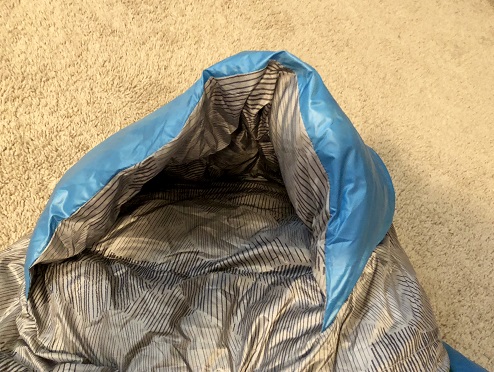 | | Toe-asis Foot Warmer Pocket |
Finally, I like the overall roominess of this bag. As I compared it to several of my other sleeping bags, this one is definitely roomier in the hips...and I appreciate that! I am primarily a hammock camper, thus I typically sleep with a quilt versus a sleeping bag (think of a sleeping bag with no zippers that opens in the back and has no hood). Because of this, I've become accustomed to the roominess I do not always get in a sleeping bag. This bag has the following girth measurements: shoulder 63 in (160 cm), hip 61 in (156 cm) and foot-box 46 in (117 cm). Just for giggles, and because I can be a gram weenie, I looked at the specifications of a 0F/-18C bag in the Fast and Light Series offered by Therm-A-Rest. That 800 down-fill bag was 9 oz (255 g) lighter than this Questar, but it was also an inch (2.5 cm) narrower at the shoulder and 4 in (10 cm) narrower at the hips! I'm personally happy to take the weight penalty for the roominess!
Although I'm primarily a hammock camper, I've had to 'go-to-the-ground' quite a bit lately based on some Scout trips I do with my son and some kayaking that isn't always hammock friendly. This is primarily why I was excited to test this bag. I also like the Synergy Link connectors. They are removable if I didn't need them, but I can't think of why I wouldn't use them! During the test series, I will likely use the bag regularly with a Therm-A-Rest Neo-Air mattress and a Therm-A-Rest LuxuryLite Ultralite cot (both of which have independent reviews on this website should the reader be interested in reviewing)!
In the accompanying images above you'll see I only have one of the connectors attached to show they are removable from the back of the bag. The front image includes my trusty trail pal Scout (named so by a Cub Scout). Every time I tried to snap a shot, he photobombed the picture and since I rarely hit the backwoods without him I suppose he felt it was appropriate to be in the shot! I'm sure he'll spend many a test night laying on top of this bag!
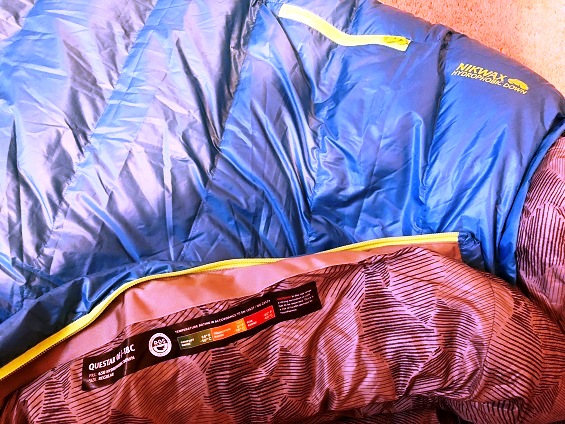 | | Comfor Rating Tag & the Zippered Pocket |
I like the idea of the foot warmer pocket on really cold evenings or when I first get into the bag. In reality, it is a little constricting and as I've already mentioned I prefer roominess, so I'll likely only use it when I first get in the bag or if I'm really cold!
The draft collars are nice and fluffy and should eliminate any air gaps at the zipper and neck. The NikWax Hydrophobic Down is a great feature since I will often be using the bag on the river. Though I hope, I never have to use this feature! In addition, the Zoned Insulation appears more than adequate. There is plenty of down on the top and sides of the bag, with minimal insulation under the torso. Insulation in this area actually becomes compressed under the weight of the body and is pointless anyway. There is also plenty of 360-degree insulation in the leg area. All great in my opinion.
Where the jury is still out...
The thing I learned about this zero (0) degree bag is that zero (0) isn't really zero (0)! It's marketed as a 0F/-18C bag, but that is actually the comfort limit or transition range. The true comfort range is 14F/-10C. The risk range, or the threat of death is -40F/-40C. Anything below 14F/-10C and you may be chilly! This is not a knock against the bag, simply something new to me. The bag falls within the EN13537 (European Standard) and ISO 23537 (International Organization for Standardization) ratings. Again, it has been a decade since I've purchased a sleeping bag and all my quilts are custom made by cottage vendors where the rating is the rating.
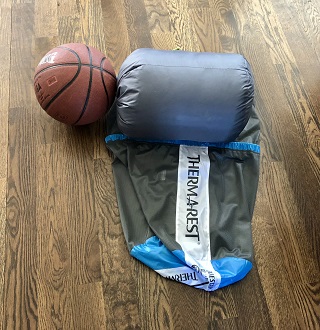 | | Questar in Stuff Sack |
I understand the quilt and blanket loop feature, but doubt I'd ever couple the bag and use them. I fret that the bag is available only in a right zip, but hey, that's the life of a lefty! I have several right zip bags and left zip ones, and can attest it is easier for me to exit a left zip.
I also don't particularly care for either the stuff sack or the storage sack. The stuff sack size is pretty bulky, larger than a basketball. I bet I could get this bag into a smaller package...and one that is waterproof. The storage sack is neat, in that, it offers two different sizes and it is made of mesh. The smaller storage size may be seen in the image at the very top of this report. That is how it arrived, and I could see using this setup during travel when I don't want it fully compressed, but I don't have a ton of room. In my car trunk perhaps. However, even at its largest this storage bag is considerably smaller than any I've ever owned. I'm a big proponent of zero compression when storing my bags, but I'm sure the engineers and designers are smarter than this end-user!
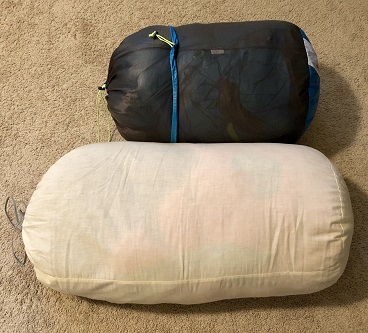 | | The Questar Storage Bag is Black |
SUMMARY
In summary, I am super excited to get this bag out into the woods! I have a kayaking trip planned for the weekend with evening temperatures forecasted to around freezing, so it should start getting use immediately.
I'm happy with all the little bells and whistles that come with this bag and excited to report to the reader in the ensuing months.
There are certainly more roses than thorns as I see it in this bag, and the negatives that I've mentioned are really nothing more than a nuisance.
FIELD REPORT
FIELD LOCATIONS AND CONDITIONS
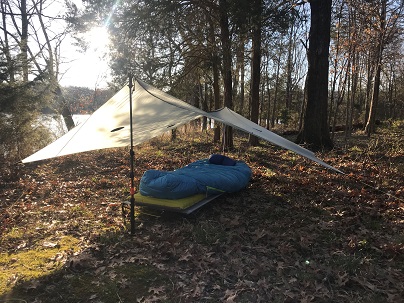 | | Questar 0F/-18C |
2 - 4 March 2018: J. Percy Priest Lake, near Nashville, Tennessee. This was a three-day and two-night kayaking trip on a local reservoir. We had planned a river trip, but extensive rains over the last two weeks made that unsafe, so we headed to the lake, which happened to be at full summer pond due to the recent weather. It went down about 6 ft (2 m) over the three days as they let water out of the dam. Currents were interesting! We paddled approximately 20 mi (32 km) over the course of the three days and spent the nights on islands maintained by the Army Corps of Engineers. It was bright and sunny every day and clear and starry every evening! Daytime temperatures averaged around 55 F (13 C) and first evening dropped to 30 F (-1 C), but the second evening I only measured 35 F (2 C). However, my damp kayak seat was frost covered down at the shoreline on that morning. I suppose it was just a little warmer up on the wooded island. Winds ranged from 10 - 14 mph (16 - 22.5 kph), so between that and the quirky currents it was definitely exercise!
6 - 8 April 2018: A three-day and two night outing on the Appalachian Trail near Damascus, Virginia. I covered a little over 30 mi (48 km) going from Damascus to Watauga Lake in Tennessee and back. The weather was clear for the first two days, but began to flurry on the final day of hiking. Highs averaged around 40 F (4.5 C) and were as low as 25 F (-4 C), but wind chills made it feel cooler.
PERFORMANCE IN THE FIELD
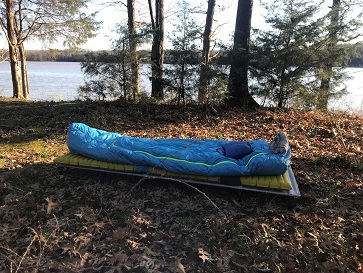 | | Kayak Cot Camping |
I used the Questar on two distinct outings during the Field Reporting portion of the test series and every night was right around freezing or colder and I never once was chilled in the bag. The coldest evening was around 25 F (-4 C), but the wind chills certainly made it feel cooler. I never made it near the 14F (-10 C) comfort threshold, but that last night had to feel pretty close to that based on the winds. I was also only underneath an open-ended tarp. I set up against the wind, but I did feel gusts at times throughout the evening.
That cool windy night on the AT outing was the only time I ever used the foot warmer pocket throughout the majority of the evening. The bag was warm enough without using it on most evenings. I did generally use it for the first ten to fifteen minutes each evening when I first hopped into bed for a little extra warmth and I found that nice.
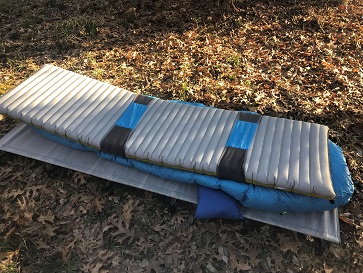 | | SynegryLink Connectors |
I used the bag every evening with a first edition Therm-a-Rest Neo-Air mattress pad. The Synergy Link connectors worked great with it! I never once slipped and although that older air pad is truly rated only to temperatures right around or above freezing, it worked well in my opinion. On the kayaking trip, I also happened to sleep on the Therm-a-Rest LuxuryLite cot that I mentioned in the Initial Review. That cot sits several inches/centimeters off the ground which also could allow air to circulate underneath the bag and mattress since I was not fully enclosed in a tent, but as I have already mentioned I was cozy every evening. I find that the zoned insulation works well.
I really enjoyed the roominess of the Questar. I could move around and stretch a little within the bag. I've become accustomed to being able to move about underneath a Quilt when sleeping in a hammock and find sleeping bags to feel a little restrictive. Many bags are very slim cut to minimize product weight and to keep the occupant warmer. The roominess of this bag did not cause an issue for me at this point.
The bag lofts up quickly even after it has been stowed away all day. The image of the bag on top of the cot was taken only minutes after I had pulled it from a compression sack. In fact, this was not the stuff sack that came with the bag. I mentioned in the previous report it was a little bulky in my opinion, but for the kayak outing I needed waterproof storage. Thus, I had used not only that, but one that compressed down tightly to fit into the hull of my boat. Later in the evening, it lofted even more, thus the warmth I'd suggest.
The draft collars worked well and I have yet to have a zipper snag. Both are features I truly have found beneficial as well as the external zippered stow pocket. I kept a flashlight handy for quick access when nature called at 3 A.M.
It has been a great bag so far, and I have used it on a several trips to flop on the floor when visiting an ill family member in there was a full house and no bed to be found.
SUMMARY
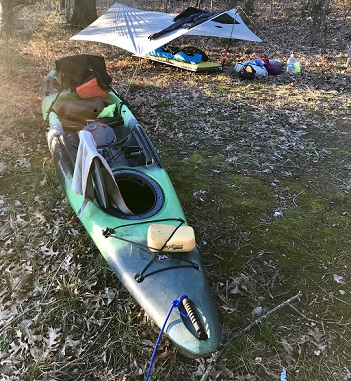 | | Home Sweet Camp |
To date I am quite impressed with the Questar 0 F/-18 C sleeping bag. In fact, the only thing that disappoints me is that I will likely not test the true limits of the bag during the Long Term phase of the test series as temperatures continue to rise. I will certainly continue to use the bag over the next several months, but I doubt I'll see temperatures that low. Even if I hit elevations in the Smokey Mountains a little warmer than that this time of year. I unfortunately missed an early May outing that would have offered some cool evenings, but as mentioned I was visiting a very ill family member.
I have plenty of roses: loft, roominess, warmth, the Synergy Link connectors and snag-free zippers. If I have to give it a thorn: I do not like either the storage bag or the stuff sack.
LONG-TERM REPORT
LONG-TERM TEST LOCATIONS AND CONDITIONS
18 - 20 May 2018; Private land on Holston Lake near Abingdon, Virginia: I hiked old farm roads and trails on the property of a family friend and camped near the lake. I covered roughly 9 mi (14.5 km) over the three-day outing. Conditions were dry, clear and hot. Temperatures in the day were around 90 F (32 C) and dropped to around 75 F (24 C) at night. Being on the lake did create a tolerable breeze.
11-14 June 2018; Boxwell Scout Reservation, Lebanon, Tennessee: as the Cubmaster of our local Scout Pack, I attended Webelos Resident Camp with about a dozen boys and a handful of their parents. Temperatures average 95 F (35 C) during the day and never dropped below 75 F (24 C) at night; and it only dropped that low on one evening during a storm. There were strong thunderstorms two of the three evenings leaving conditions humid throughout the night. The days were dry and hot.
13 - 14 July 2018; Green River near and inside of Mammoth Cave National Park, Kentucky: This was an overnight kayaking trip that covered 30 mi (48 km). It was bright and sunny and I did not even deploy a tarp at night, as it remained clear. Daytime temperatures reached 95 (35 C) and evening temperatures did drop to 68 F (20 C). I camped on the flood plain, but up on the riverbank about 25 ft (7.5 m) above the waterline, so this limited the breeze. I slept in a hammock on this outing.
PERFORMANCE IN THE FIELD
We had no spring season in Tennessee. It was unfortunate, as this is generally one of my favorite seasons to backpack and it made evaluating this product a little difficult! I used the sleeping bag on three distinct outings, but was honestly overkill for all three as the lowest overnight temperature on the six nights I used it was 68 F (20 C). That stated, I still enjoyed using it and look forward to extended use this winter.
One observation that comes to mind is the need for the SynergyLink Connectors in warmer weather. They became unneeded. I initially connected them to both my air mattress on my lake backpacking trip and to a vinyl cot mattress at Scout camp. However, I quickly learned that I had to actually crawl into the bag, or lay in an unzipped and folded back bag when they were deployed. It was so warm that I preferred not having to do this, so I decided to remove the connector system and simply drape the bag near me. I typically covered up in the early morning hours when it became the coolest; this was typically around 4 or 5 AM. Even then, I never actually crawled into the bag; I merely draped it over my torso and legs.
To clarify, I'll expand on the just mentioned vinyl mattress from the Resident Camp. In this setting, I slept in a classic canvas Scout walled tent setup on a wooden platform with a rack/cot. There was a 4 in (10 cm) thick vinyl covered mattress on the rack. I put a standard twin sheet over the mattress, but also used the connectors initially. I learned quickly, just as I had on the previous trip, that I needed to remove them. That stated, they do their job! They keep the bag from sliding around and I certainly see them as an asset for cold weather use!
Two of the three nights at this Scout camp brought some severe thunderstorms and plenty of rain. After that came the humidity! Even with the sidewalls and door flaps of the tent rolled up it was warm and muggy. I also was inside a boxed style mesh bug net and that in itself felt like it was trapping additional heat. The positive feature was that the down bag repelled this humid and moist weather amazingly well. It was never damp to the touch and the down remained at full loft.
I used the bag on one final kayak outing in mid-July. Again, it was overkill for the season, but I took it along. This time I used it for the first and only time in a hammock. Sleeping bags can be particularly problematic to use inside a hammock as slipping inside of them is difficult when suspended. Due to this many, hammock campers use a quilt. I used the bag more like a quilt on this evening and as this was the coolest evening of the summer use, I actually did cover up around midnight. I worked well in this situation, though I am sure I will not use this bag in a hammock in the cold winter month as it is simply too much of a task to enter and exit.
Overall, the bag performed quite well in my opinion, I am just frustrated the season grew so hot...so quickly. This, however, is Mother Nature's call and not mine!
SUMMARY
In summary, I'm fully satisfied with the Therm-a-rest Questar sleeping bag, perhaps not so with the conditions I encountered during the test series. Temperatures went from Winter-like to full Summer-like overnight and that was problematic for fully evaluating this product. I never experienced discomfort or cold spots on the nights it did fall below freezing and I'm excited about that. Based on that I do plan to use this bag for future winter camping. I do tend to hammock camp regularly also, and I do not see it suitable for such use in the winter, but with the reintroduction of Scouting into my life, I tend to have to sleep on the ground more than I have over the last decade or so. Therefore, this is a great addition to my gear stash!
I will again reiterate as I did in my Field portion of the test series that roses include the loft and roominess. The Synergy Link connectors were unnecessary for the recent temperatures but I do still enjoy the snag-free zippers. Finally, the only thorn in my opinion is that I do not like either the storage bag or the stuff sack. I will likely never use the stuff sack again in the backcountry. Instead, I will replace it with a smaller compression sack.
This concludes my test on this product. I would like to thank both BackpackGearTest.org and Cascade Designs, Inc. for allowing me to test the Questar 0F/-18C sleeping bag.
This report was created with the BackpackGearTest.org Report Writer Version 1.
Copyright 2018. All rights reserved.
Read more reviews of Therm-A-Rest gear
Read more gear reviews by Steven M Kidd
|




